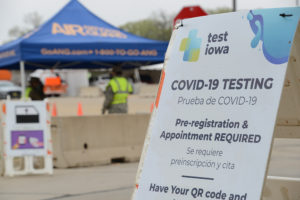COVID-19 Testing Deserts and Treatment Barriers
 A sign at the entrance of a Sioux City, IA COVID-19 testing site on May 7, 2020 (photo by U.S. Air National Guard photo by Senior Master Sgt. Vincent De Groot)
A sign at the entrance of a Sioux City, IA COVID-19 testing site on May 7, 2020 (photo by U.S. Air National Guard photo by Senior Master Sgt. Vincent De Groot) COVID-19 cases were on the rise in the United States while death rates continued to fall—at least until recently. According to the Washington Post‘s COVID-19 track, since July 10 death rates have been on the rise as well. These increases come on the heels of re-openings in states across the country, as it becomes increasingly evident that the US is struggling to gain control over the pandemic. Even President Trump, who has downplayed the coronavirus pandemic from day one, said Tuesday “it will get worse before it gets better.” Federal, state, and local leadership must refocus its efforts not only on compelling socially distancing, but also on increasing access to testing and treatment, and on safe vaccination development—especially as these efforts affect vulnerable communities.
As the pandemic began to spread throughout the country Black and Brown people were either getting infected or dying at significantly higher rates due to preexisting medical disparities and testing deserts within these communities. Black and Brown people were additionally likely to feel the economic impact of COVID-19 at heightened rates. It’s no secret that general health disparities in Black and Brown communities can be attributed to lack of access to affordable healthcare and persistent discrimination in the healthcare world.
Treatment is also another difficult hurdle for minority communities. As Black and Brown communities are taking harder hits economically during this pandemic, taking time off work for treatment risks not having enough money for rent or food on the table. Pushes to cancel rent haven’t gained much traction, and food distribution sites are only a temporary solution.
Undocumented immigrants and mixed-status families are also seeing barriers to treatment and testing. While the last CARES Act provided millions in funding for COVID-19 testing for uninsured people, most of this funding is tied to Medicaid, which has a citizenship requirement. Undocumented immigrants can still seek testing and treatment at free clinics, but as FiveThirtyEight has found, these clinics in Black and Brown communities are scarce. Additionally, direct funding for testing and treatment for immigrant is needed. As the next COIVD-19 relief bill is likely to be voted on in early August, it’s imperative to include funding for testing and treatment (including future vaccines) for all, regardless of immigration status.
Unless all communities have access to testing and treatment, it will be nearly impossible to contain the COVID-19 infection. Millions of people are struggling with the financial fallout of the pandemic, but vulnerable Black and Brown communities are especially at risk when it comes to accessing testing and treatment, including any future vaccination. Public health is everyone’s health, and unless there is increased funding for testing and treatment accessibility, the country will never get past the pandemic.
